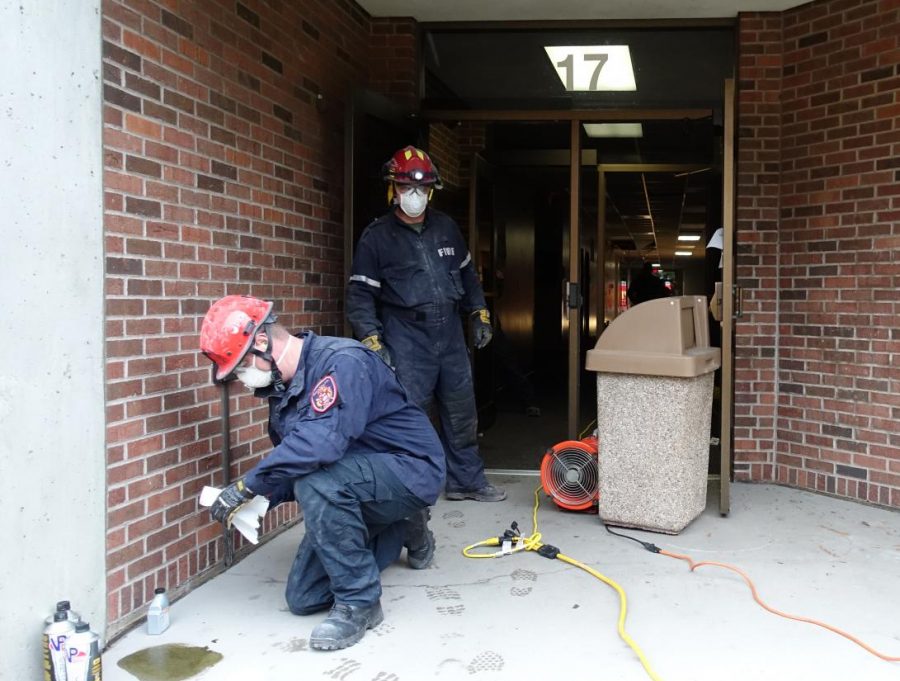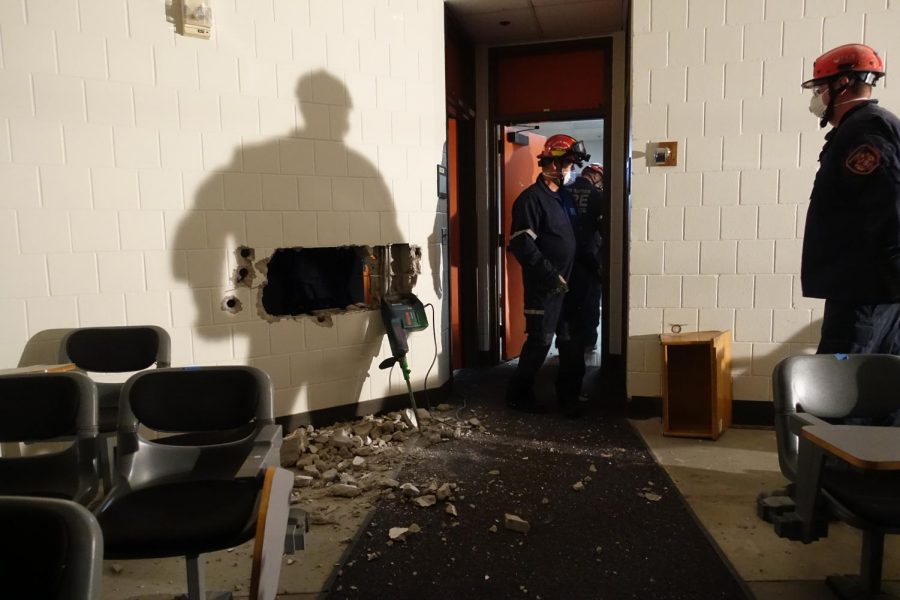The dangers of pretending to fight a real fire.
Anoka-Ramsey gives the Coon Rapids Fire Department a rare chance to train for future emergencies.
Masked firefighters prepare to entire the Business and Nursing building at the ARCC Coon Rapids Campus.
June 30, 2021
As the Anoka-Ramsey Coon Rapids campus announced their Business and Nursing building renovation, the Coon Rapids Fire Department found a fire and rescue training opportunity.
The training took place after the approval of the Fire Marshal Todd Williams and Facilities Director Ken Karr. It lasted a the whole week of May 24.
“Todd Williams approached me and I told him that I would see if I could get him into the building and I found him a window” said Karr about the week he was able to schedule the fire department for the training.
“We don’t get opportunities to train in buildings that are vacant where we have to worry about scuffing the floor and breaking something,” said Assistant Fire Chief Aaron Johnston, who was in charge of the training on campus.
For the training, it was necessary to create a challenging scenario, one like a real fire. Lights were turned off in the building, smoke machines were involved, and a training mannequin was placed in a classroom with sloped floored. Firefighters then had to use a thermal imaging camera to locate the mannequin and practice rescuing it.
“We pretend we’re fighting a real fire, or looking for a student that is down, or a faculty member who is unaccounted for,” Johnston said.
Firefighters had the opportunity to practice hooking up water hoses and dragging them inside in the shortest amount of time possible. A challenging experience considering the amount of weight a firefighter carries when running inside a building.
Every inch and a half section of hose is roughly 100 pounds per 50 feet when filled with water. There is “a set of irons,” which is an axe and a halligan–a prying tool with a fork on one end with a pick. This adds an additional 20 to 30 pounds. Adding to that, such as a flashlight and thermal imaging camera.
“It is about 50 to 60 pounds extra weight with our turnout gear,” said Johnston.
Johnston explained the importance of being strategic when locating the scene of the fire, since the most hose the fire department uses to go into any large structure is 150 feet. Going any further makes it difficult to run the hose out, putting fire fighters at risk of a swift evacuating.
“You just have to pick the right door,” Johnston pointed out.
He continued by explaining that buildings like ARCC Coon Rapids are designed to have a door every 50 feet or less. This makes civilian evacuation and firefighters entering easier.
Some other things that firefighters had to keep in mind during a training are muscle injuries, even though they move slower compared to real life situations.
Firefighters enter a building with air packs with about 45 psi of compressed breathable air during trainings and real emergencies. When their air level drops to 50 percent, they are leave the building. This allows enough time for a firefighter safely exit. After that, they rehabilitate, refreshing themselves with food or water and about 10 minutes of rest.
On May 27, the Specialized Rescue Team performed a separate training on campus. Their training was focused on structural collapse, which consisted of breaking and breaching through walls.
Fire Capt. Justin McCullen explained how this type of training does not happen very often because of the destruction that has to be done and the type of tools that are used. When the opportunity does come, they take it even if this means putting some other trainings on hold.
Some challenges that this training included was learning to use the proper tools depending on the types of walls and the situation. Wall types vary from sheetrock to concrete. Some of the tools used include core drills, electric hammer drills and gas driven hammer drills to brake through concrete.
“We can drill a hole and put a camera or microphone, so in a real structural collapse we can search for victims or listen for people who are making noises for us to come rescue them,” said McCullen.
The team was able to practice being cautious of water hazards and pipes underground or in the walls, as well as of the electrical wiring in the building, which is a highly important action in both trainings and real-life, even though during the training all the breakers are turned off by electricians.
“We are still practicing as if [the electric wiring is] alive. We have a tool to be able to check to see if there is electricity in those wires,” McCullen said.
The lighting is another factor kept in mind, as it is lacking in these scenarios. McCullen explained how it is necessary to bring as much light from the outside as possible whether it is through windows, flashlights, portable plug lights or generators. Extra ventilation is also needed for the dust and the engines’ exhausts.
Some other safety measures taken by the team were using helmets, face masks, fire suits and earplugs to protect themselves.
“Again [it is] all about training and getting our mind wrapped around how would we do this if it was real,” Johnston said.


